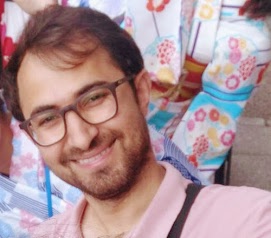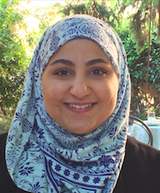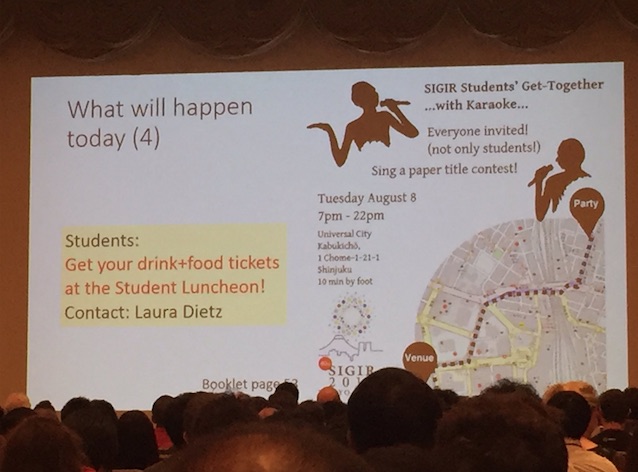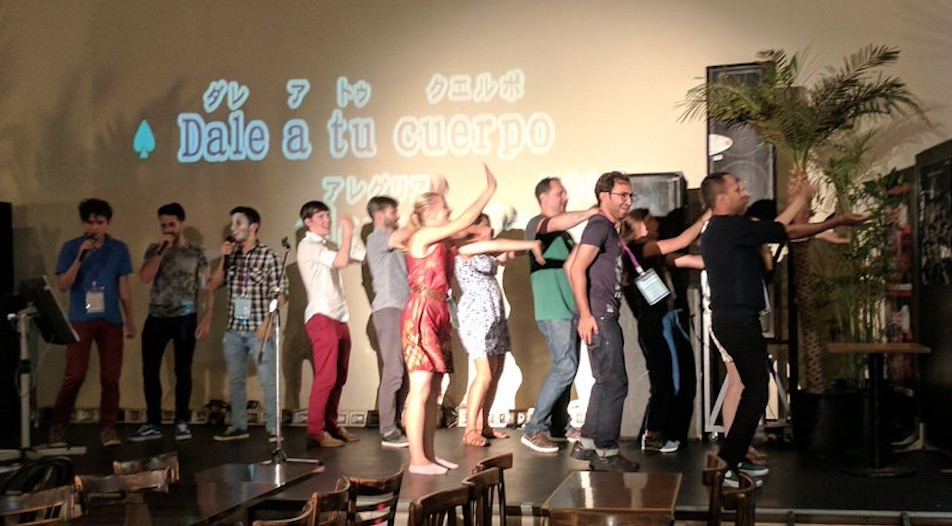
こんにちは。ようこそHello and welcome!
SIGIR came to a successful conclusion, and I was just getting ready to retire from blogging (at least for a while) when I received an e-mail about the new SIGIR Student Liaison Program from Johanne Trippas, whom I had the pleasure of meeting at the conference.
Her enthusiasm convinced me to write an addendum to my series of blogs on SIGIR 2017.
The Student Liaison Program is the brainchild of Diane Kelly, current Chair of the ACM SIGIR Executive Committee and Professor and Director of School of Information Sciences at University of Tennessee.
The program was established to address the need to reach out to students who do not have access to mentors at early stages of their careers and the means to professionally network. A disproportionate number of these students are from traditionally under-represented groups, developing countries, or less wealthy universities. Their active participation would undoubtedly enrich the lives of the SIGIR membership at-large though creation of greater awareness of diverse viewpoints and trusting relationships with people with first-hand knowledge of research problems whose solutions would have great societal impact.
The mission of ACM SIGIR’s Student Liaison program is:
- Every student attendee is improving her or his network.
- No student is left behind… or alone in the corner.
- Ensure ideal conditions for all students to thrive.
The current mission statement is considered to be a starting point since technologies are in constant flux, as are world events. Suggestions for additional points are welcome to help the program grow and remain relevant over time.
Diane’s idea for a formal Student Liaison Program sprung up during an informal get-together organized by Laura Dietz (professor at University of New Hampshire, USA) to help students, particularly first-time attendees, from diverse backgrounds break the ice and build personal and professional friendships. The students were clearly enjoying a friendly, unpretentious atmosphere that encouraged pursuit of a career in computer science. Their words and gestures of appreciation did not go unnoticed. Diane asked Laura to serve as the founding Student Affairs Chair, the official contact point for Student Liaisons. Laura’s extensive academic achievements, organizational experience and soft skills in managing people, along with her friendly, positive and energetic demeanor made her a natural choice. Laura is known in academia for her research work on how to best utilize knowledge graphs for text-centric information retrieval. She is organizing the TREC Complex Answer Retrieval track.
To test the waters, Diane floated the idea of establishing a Student Liaison program at informal gatherings at SIGIR 2016 to determine student interest and whether there would be qualified students who would like to serve as a liaison. Diane was and remains very interested in concrete suggestions for activities. Mohammad Aliannejadi, a student at Università della Svizzera Italiana in Switzerland, who was at one of the gatherings, was excited about the idea and knew right away that he wanted to participate. Numerous positive responses convinced Diane to send out an invitation to the SIGIR community for student volunteers.
To apply for a Student Liaison position, applicants were required to submit an essay outlining reason(s) for applying and vision for the program, including professional and social activities to promote an inclusive and supportive atmosphere. Mohammad was watchfully waiting for the call for volunteers, and he applied right away when he saw the posting. Johanne Tripass, a student at RMIT in Australia, saw the invitation and was mulling over whether to apply. Encouragement from her academic advisor gave her fresh impetus to gather together concrete ideas for activities for students interested in IR, write an essay and send it in. Hamed Zamani of the University of Massachusetts Amherst saw the posting and felt it would be a great opportunity to help other students. Hamed was a student in Iran when he decided to apply to one of the leading centers of IR research. Experiencing the academic and industrial opportunities in both Iran and the U.S. has helped Hamed to be familiar with diverse sets of needs that students have in the IR community.
All of the applications that were received were outstanding, re-assuring the Selection Committee of the high caliber of the next generation of SIGIR members. However, to keep the program a manageable size during the start-up phase and to ensure a heterogeneous geographic distribution, a decision was made to hold the initial number of Student Liaisons to six.
The Founding Liaisons are:
- Mohammad Aliannejadi of Università della Svizzera Italiana, Lugano, Switzerland, whose research work is concerned with contextual suggestion and spoken language understanding, and combinations of different relevance criteria for mobile IR (e.g., topical, temporal, geographical).
- Maram Hasanain of Qatar University, Qatar, whose research work is concerned with IR tasks over tweets and automatic IR system evaluation.
- Jiaxin Mao of Tsinghua University, Beijing, China, whose research work is concerned with user behavior analysis and evaluation for web search engines through building user models to infer users’ intents, experiences, and satisfaction from their interactions with the search engines.
- Jaspreet Singh of L3S Research Center at Leibniz University Hannover, Germany, whose research work is concerned with retrieval models (new ranking algorithms, search user interfaces, and evaluation metrics), exploratory search, neural retrieval models, and interpretability of complex retrieval models.
- Johanne Trippas of Royal Melbourne Institute of Technology (RMIT) University, Australia, whose research work is concerned with search engine result presentation over an audio-only communication channel and how conversations can be structured between the user and spoken conversation search system.
- Hamed Zamani of the University of Massachusetts Amherst, USA, whose research work is concerned with modeling core IR problems (e.g., query representation, document representation, and ranking) using deep neural networks and theoretical approaches to information retrieval.
Activities supported by the Student Liaison program were launched this summer at SIGIR 2017, which was a good first testing ground. In industry, we would call it the “proof-of-concept” or “prototyping” phase. Fortunately, thoughtful discussions before activities made them very successful – sometimes too successful. The two main activities offered at SIGIR 2017 were:
1. The Student Buddy Program, which aims to help students and first-time attendees build their own professional network by matching them with “old foxes” at the conference. The old foxes serve as “Big Buddies (who) take the initiative of arranging some small gatherings or a short discussion.” This program was very successful; maybe even too successful. Despite a last-minute announcement two days before the conference, close to 15% of pre-conference registrants signed up as a first-time attendee or old fox. Most of the sign-ups were by new attendees, so each old fox had many mentees to guide. Since one-on-one mentoring was clearly impossible, the old foxes arranged for group meetings, during which mentees could meet one another and make friends at the outset. In the future, the announcement will be made much earlier in the hope of recruiting more foxes to reduce the number of mentees assigned to each.
2. A Student Luncheon and Evening Party – to help students build professional and personal networks. Free lunches with delicious food are always a big hit with students.
SIGIR was held in Japan, the birthplace of Karaoke, so a song and dance party on stage was the natural choice for the main evening activity. “Tonight we sing!” tweeted Mohammed, as he challenged brave souls to participate in the “Sing a Paper Title Contest.”
Everyone, including students, regular SIGIR registrants , and Diane Kelly, had a terrific time. Reflecting the main theme of the conference (diversity), a very diverse selection of melodies, including, “We Are the Champions” and “The Macarena,” had people dancing.
The Student Liaisons’ biggest upcoming challenge for SIGIR 2018 may be to top the fun and excitement of the 2017 Karaoke party.
(Note: The program to assign mentors to students preparing presentations of their Ph.D. theses existed prior to the Student Liaison Program, and is considered to be the responsibility of officers of the main conference.)
The Student Liaison Program is currently working towards several other goals, including:
- Helping students and all interested people in information retrieval connect on social media sites for active and robust academic discussions on open problems, technical issues, etc. The Liaisons have launched IR groups on Twitter and Facebook, and they recommend a well-established ACM group on Slack for people interested in reaching out to a wider group of ACM members. The first two were launched prior to SIGIR and were used extensively to disseminate information as well as photos from events during the conference. All three are open to all interested scientists and prospective scientists, regardless of membership status or affiliation with the ACM. The liaisons look forward to establishing an informal pipeline for exchange of information and collaboration with scientists in other academic areas.
- Helping students clinch their first internship. Concrete ideas for developing this idea are welcome, since this initiative is still under development.
- Lobbying for a Student Reviewer Program for SIGIR-sponsored conferences. The intent of the proposed program is to help students learn about the manuscript review process and become better future reviewers. The current draft of the proposal states that student reviewers should not replace any members in the regular paper review panel. If the panel agrees, a student will be permitted to read a submitted manuscript and write a review. If any step of the review process is ambiguous, student reviewers may ask other panel members for help or advice. I believe the proposed program will help students become better writers since they will understand how their manuscripts will be regarded by a panel of reviewers. I remember when I received my first driver’s license, my father remarked that becoming a driver would make me a better pedestrian since I would better understand the viewpoint of drivers: their capabilities and limitations.
The current proposal stresses that student reviews are not meant to carry weight in the final decision process, and the review panel is not required to take any comments in the student review into account. However, in special cases, opinions can be taken into consideration by regular panel members during the decision-making process. For example, Information Retrieval and Search has become a central part of most Web interfaces for businesses, and not all people who read the Proceedings are experts in the field. If the main contribution and main message of a manuscript cannot be understood by an educated computer scientist (such as a graduate student at a major university), my personal belief is the abstract and introduction need to be re-written, regardless of the caliber of the technical accomplishments described in the remainder of the paper. Suggestions, ideas, criticisms regarding the proposal as well as other student activities are welcome.
Regardless of the outcome of the proposal for a Student Reviewer Program, I recommend readers to take a look by an insightful article by Moshe Vardi (outgoing Editor-in-Chief of the Communications and professor of Computational Engineering and Director of the Ken Kennedy Institute for Information Technology at Rice University) on the flaws of the current conference manuscript peer review process.
In closing, I cannot stress enough that the main message of this blog is: Student Liaisons are responsible for “listening to critiques and sensitive subjects as well as suggestions for improvement from the student body. (They) are the Go-To Point for student participants in their geographic region.” Please feel free to contact them via the official website.
While I was writing this blog, I received an e-mail from Laura saying, “We will have another call next spring (watch out!). Our goal is to have 9 liaisons in total, also replacing liaisons that graduate. We (will continue to) select a regional diverse set as well as (a mix of) some junior and some senior graduate students.” My advice: Don’t be shy, apply to volunteer! It will be a fantastic experience working with fantastic people in ACM SIGIR.
Thank you for joining me on my final blog on SIGIR2017.
I hope to see you again in the future! … またどこかでお会いできるのを楽しみにしております
My previous blogs on SIGIR are:
Blog #5 SIGIR 2017: Closing Blog
Blog #4 Keynotes at SIGIR 2017
Blog #3 SIGIR2017: Diversity and Inclusion
Blog #2 Neural Networks in IR: full-day tutorial
Mei Kobayashi is manager, Data Science/Text Analysis at NTT Communications.














Join the Discussion (0)
Become a Member or Sign In to Post a Comment